CMS-10398 (#20) User Guide - PERM Round 2 Proposal Submission
Generic Clearance for Medicaid and CHIP State Plan, Waiver, and Program Submissions
User Guide Round 2 Proposal Submission [rev 9-11-2014 by OSORA PRA]
Bundle: PERM Pilot (#20), Same Sex Marriage (#36), and Managed Care Rate Setting (#37)
OMB: 0938-1148
CMS PERM – PETT 2.0 Round 2 Pilot Proposal Submission
User Guide Documentation
July 21, 2014
PRA Disclosure Statement
According to the Paperwork Reduction Act of 1995, no persons are required to respond to a collection of information unless it displays a valid OMB control number. The valid OMB control number for this information collection is 0938-1148 . The time required to complete this information collection is estimated to average [Insert Time (hours or minutes)] per response, including the time to review instructions, search existing data resources, gather the data needed, and complete and review the information collection. If you have comments concerning the accuracy of the time estimate(s) or suggestions for improving this form, please write to: CMS, 7500 Security Boulevard, Attn: PRA Reports Clearance Officer, Mail Stop C4-26-05, Baltimore, Maryland 21244-1850.
Table of Contents
2.0 User Registration and Login 3
2.3 Password Retrieval Feature 6
4.0 Round 2 Pilot Proposal Submission 9
4.1 Section 1 - General Information 15
4.2 Section 2 –Background Information 16
4.3 Section 3 – Sampling Unit 17
4.4 Section 4 – Sampling Frame Construction 18
4.5 Section 5 – Sampling Frame Time Frame 19
4.6 Sections 6 – Sampling Frame Exclusions 20
4.7 Sections 7 – Sampling Frame Quality Control 22
4.9 Sections 9 – Case Review 24
4.10 Sections 10 – Payment Review 27
4.11 Sections 11 – Additional Comments 27
5.0 Submission and Review of Round 2 Pilot Proposal 28
5.1 Submission of Round 2 Pilot Proposals 28
The State Health Official Letter 13-005 directs states to implement Medicaid and Children’s Health Insurance Program (CHIP) Eligibility Review Pilots in place of the Payment Error Rate Measurement (PERM) and Medicaid Eligibility Quality Control (MEQC) eligibility reviews for fiscal year (FY) 2014 – 2016. States will conduct four streamlined pilot measurements over the three year period. This guidance is intended for Round 2 pilot proposals for the review of state eligibility determinations.
Similar to Round 1, the Medicaid and CHIP Eligibility Review Pilots consist of two independent components. States are required to:
Pull a sample of actual eligibility determinations made by the state and perform an end to end review (reported through PETT 2.0)
Run test cases- (not reported through PETT 2.0)
States are required to enter their Round 2 pilot proposals directly to the PERM Eligibility Tracking Tool (PETT 2.0) website. An upload feature will not be available and CMS will not accept emailed versions of the template. States will be able to save the proposal as a draft before submitting a final version to CMS. Once the final report is submitted to CMS, the review and approval process will be managed through the PETT website. CMS will review and provide comments or approval within 2 weeks. If CMS does not approve the proposal, states will have 1 week to revise the proposal based on CMS comments.
The PETT 2.0 website is accessible to authorized system and program administrators (i.e., CMS and its contractors), state administrators, and state viewers who monitor data submission or provide input to the PERM program. Users will have different website privileges depending on their program roles. During the registration process, state users will be asked to select which level of access they are requesting – state administrator or state viewer. Users will be approved by CMS and Lewin after the state eligibility lead notifies CMS and Lewin regarding which individuals should have access to the website. Note: State users already registered for PETT 2.0 to submit Round 1 pilot findings will not need to re-register to submit the Round 2 pilot proposal.
The remaining sections of this document describe how to access and use the PETT 2.0 website.
To access this feature: Go to the PETT 2.0 website which can be accessed at the following web address: https://www.cmspett2.org.
The login screen is the first screen that users will see when they go to the PETT 2.0 website. New users will need to register. If you have already registered, enter your case-sensitive user name and password and click the “Login” button.
If a user is inactive for 15 minutes, the user will have to login again to continue working. The user will be returned automatically to the web section they had been working on.
Figure 1: Login screen
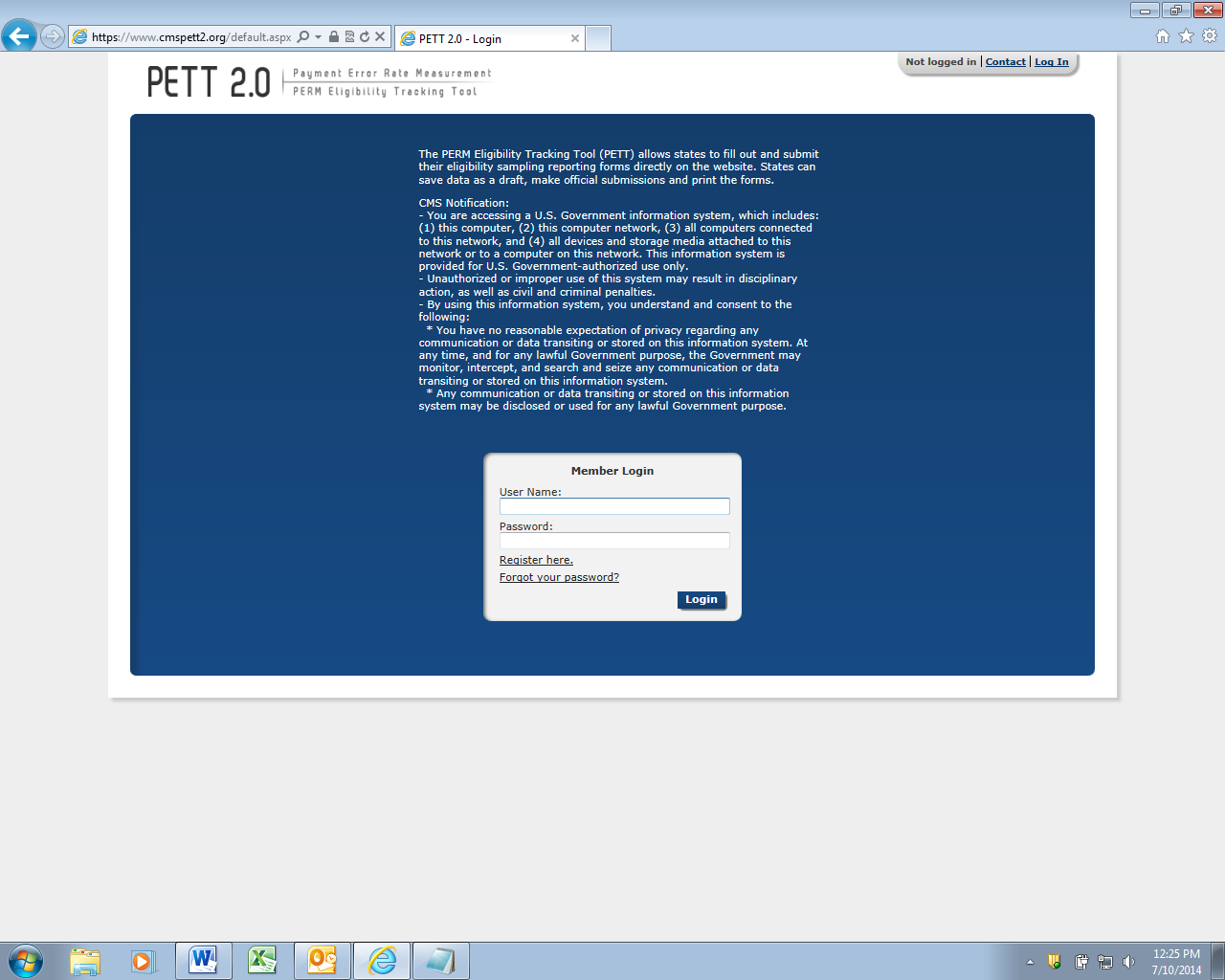
To access this feature: Click the “Register here” link on the login screen.
Figure 2: Registration page
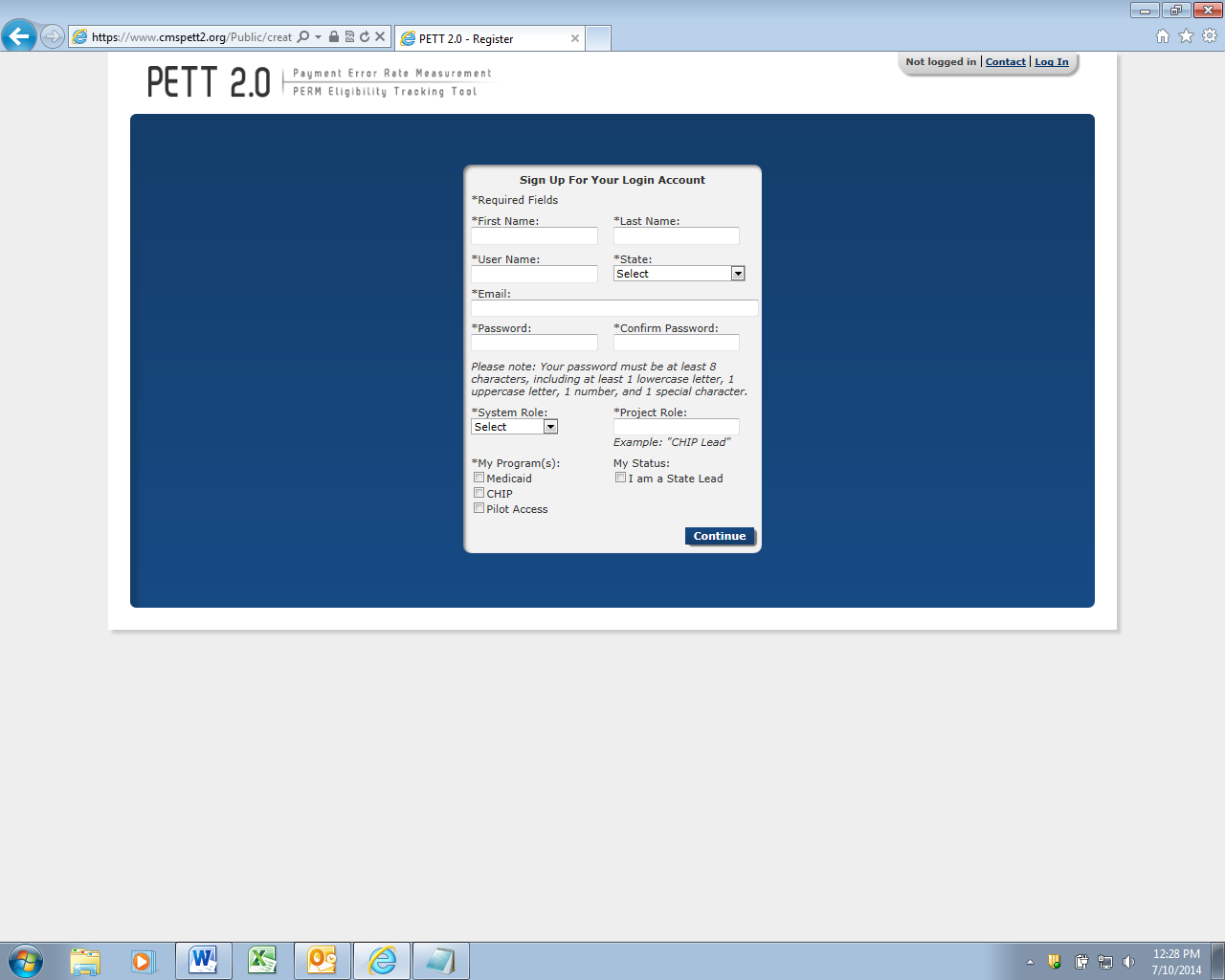
New users must register for access to the PETT 2.0 website. Each state will be allowed to have up to three users. Each state user will be designated as either a state administrator or a state viewer. State administrators will be able to input, edit, and review their state’s pilot review findings, while state viewers will only be able to review their state’s submitted pilot review findings.
During the registration process, state users should select the appropriate level of access from the “System Role” drop-down box. State users should also identify their “Project Role” (e.g., CHIP lead, reviewer, state contractor). The state PERM eligibility lead has the option of selecting the box under “My Status” to indicate their role as the State Lead.
Users need to check “Pilot Access” under “My Program(s).” The Medicaid and CHIP boxes are for FY2013 routine PERM eligibility users only. NOTE: If pilot users currently have access to PETT 2.0 for the FY2013 PERM eligibility cycle, users should submit an email to [email protected] or utilize the Contact feature, described in Section 3.3, to contact system administrators who will update the user’s access to allow the user to view the pilot functionality on the website.
New users will need to create a case-sensitive user name and password. Passwords must be at least eight characters long and contain at least one of each of the following:
A number
An upper case letter
A lower case letter
A special character !#$%&()*+,-./:;<=>?@[\]^_{|}~
Users will need to change their passwords every 60 days; after changing the password, the user will need to login again.
All new account registrations are sent to system administrators (CMS and Lewin) for review. If they approve the new user, the system administrator will enable the account and send the new user a “User Account Approved” email with login instructions. Confirmation emails will be sent from [email protected] typically within 48 hours of registration. To ensure that emails are received, users should add [email protected] to their contact list and follow up with CMS and Lewin if confirmation is not received within 48 hours.
To access this feature: Click the “Forgot your password?” link on the login screen.
Users should enter their user name. A new password will be sent to the email address associated with the user name. Users can only reset their password once per day.
Forgotten user names can only be retrieved by contacting the system administrators, which can be accomplished using the contact form (described in Section 3.4).
Figure 3: New password dialog box
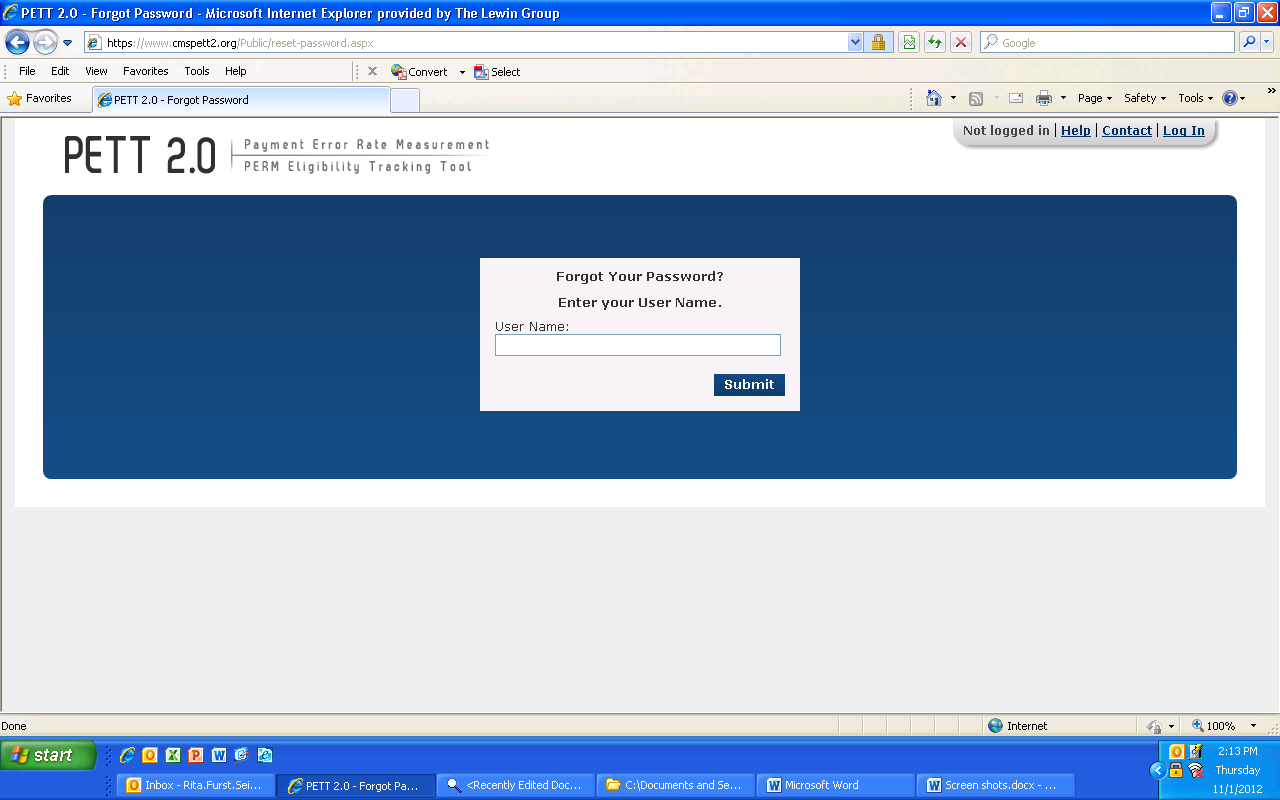
To access this feature: Click the “Manage My Account” link in the upper right navigation bar.
The Manage My Account page allows users to perform account management tasks such as changing their password, name, and contact information.
Users cannot update their user name, system role, state, program, status as state lead, or preference to receive notifications. To change these settings, users should contact the system administrators using the contact form (described in section 3.3).
Figure 4: Manage My Account screen
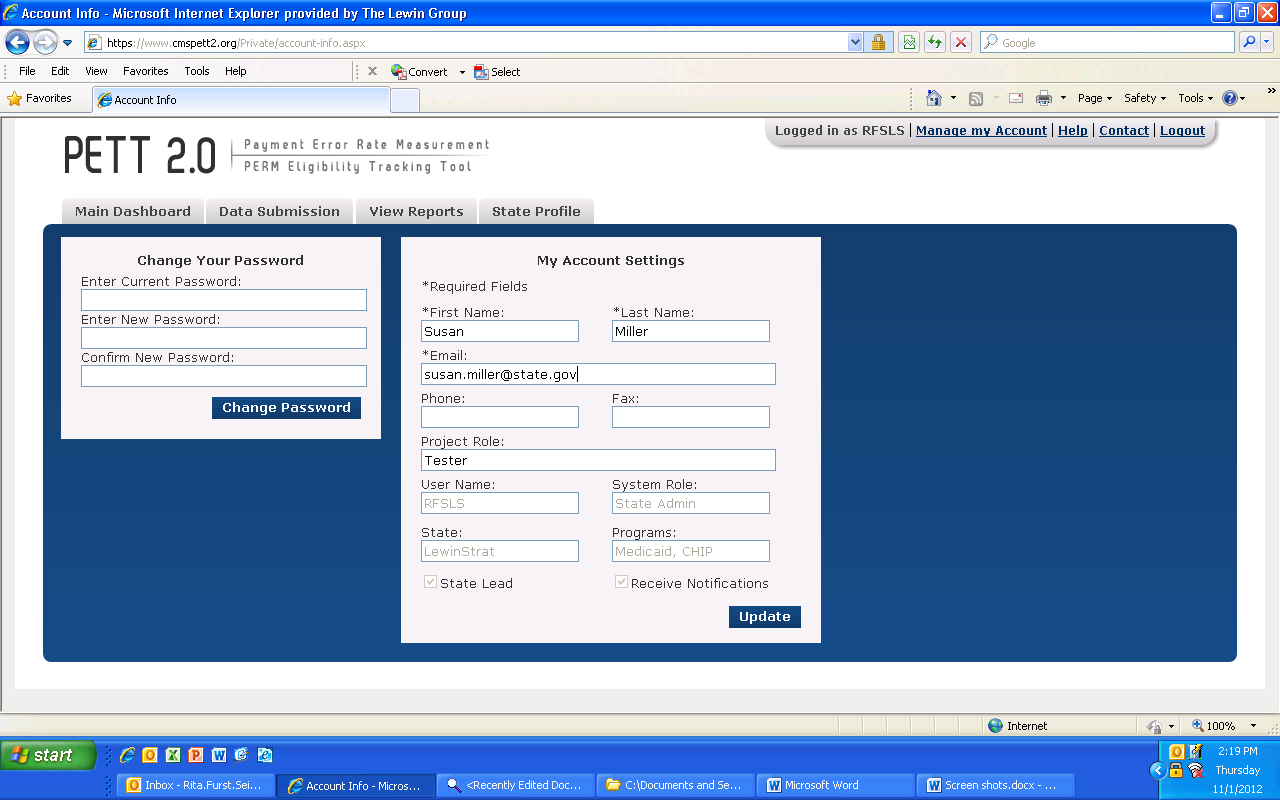
If a user selects the Help link, the user will be directed to the PERM FY13 PETT 2.0 user guide. Users can also send questions they may have related to the Round 2 Pilot Proposals to [email protected].
To access this feature: Click the “Contact” link in the upper right navigation bar from any area of the system.
PETT 2.0 contains a Contact feature allowing users to submit questions and comments directly to system administrators. The system administrators will be able to assist users with any issues users may encounter including data submission errors and PETT 2.0 website use. Users will receive a response to their messages typically within 48 hours of submission. To ensure that they receive a response, users should add [email protected] to their contact list. NOTE: System administrators from Lewin will be available for any technical assistance needs. If a user encounters an issue that is not easily resolved via email or if the question is complicated, please request a teleconference and a Lewin administrator will contact the user via telephone, utilizing WebEx functionality, as needed.
The contact form can be accessed even if users are not logged into the PETT 2.0 system.
Figure 5: Contact screen
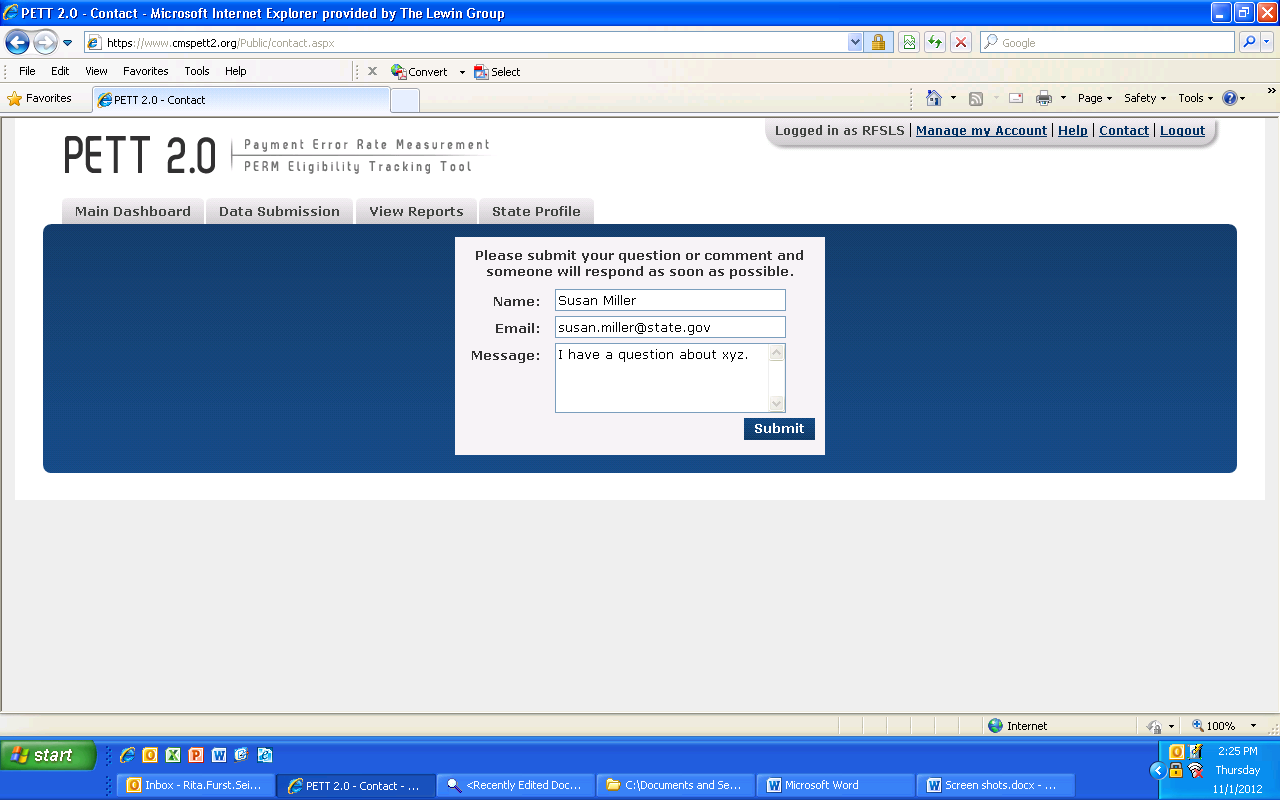
To access this feature: Hover your mouse over the “State Profile” tab and click on “View State Details.”
The State Profile shows the list of users for the selected state. Each row shows the contact name, email address, user name, programs assigned or pilot, system access role, project role and lead.
Figure 6: State Profile
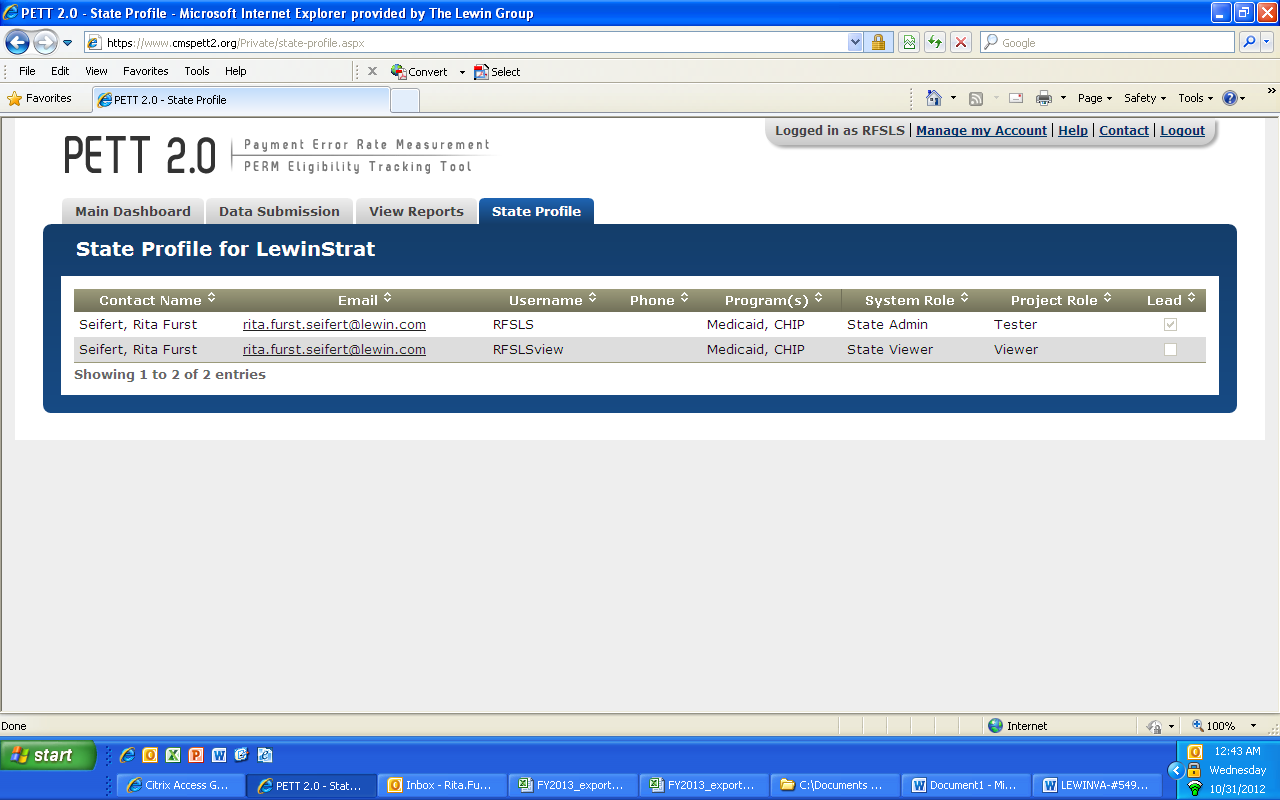
States are required to enter Round 2 Pilot Proposals directly on PETT 2.0. After a successful log-in, states are directed to the home page of the PETT 2.0 site, as shown in Figure 7.
Figure 7: PETT 2.0 Home Page
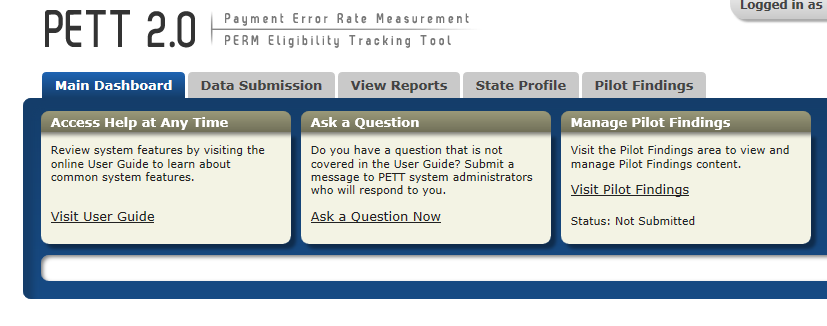
From the home page, states can navigate to the Pilot Proposal reporting section by hovering over “Pilot Findings,” and clicking on the drop down, “Round 2 Pilot Proposal,” as indicated in Figure 8.
Figure 8: Navigating to Round 2 Pilot Proposal
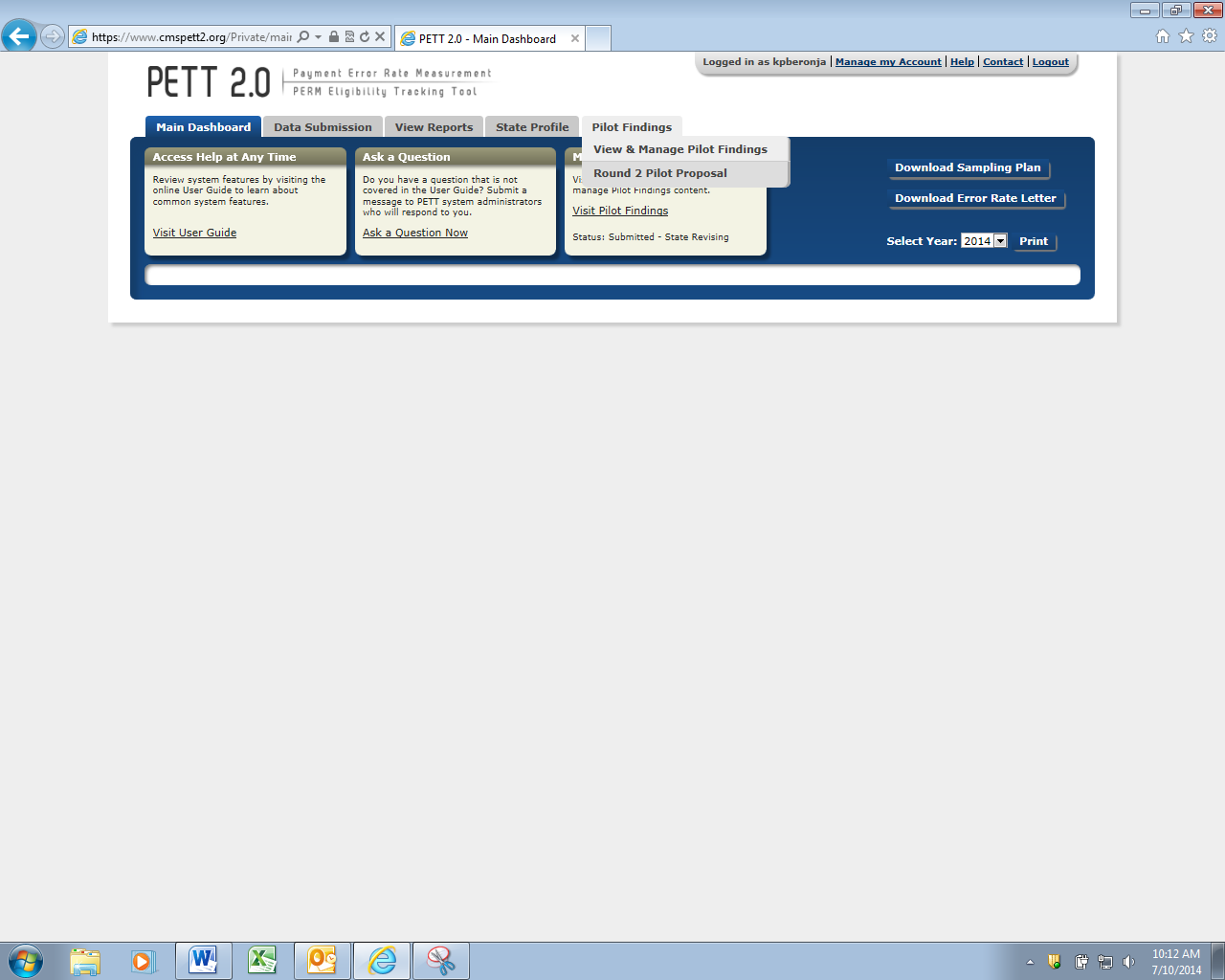
After navigating to the Round 2 Pilot Proposal, states will click the “Create New Round 2 Pilot Proposal,” enter their version, and hit the “Create” button, as indicated in Figure 9. If a state has made significant changes to their proposals prior to submission, they can decide to create a new version, rather than making the changes in the original proposal.
Figure 9: Creating a Round 2 Pilot Proposal

Once the state hits the “Create” button, they will be taken to the Pilot Proposal report, as shown in Figure 10.
Figure 10: Initial View of the Pilot Proposal
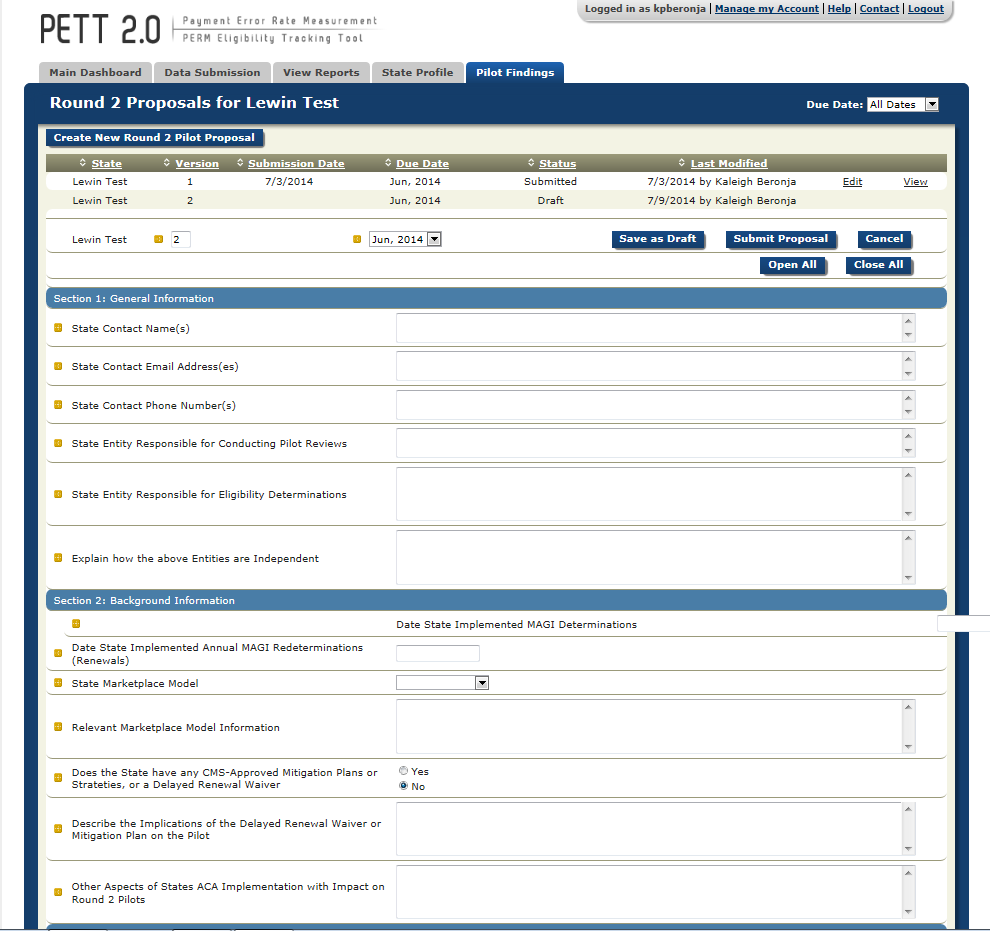
Once the user has entered the Round 2 Pilot Proposal report, shown in Figure 10, states will be able to populate each section.
If states are only entering part of their proposal information during a single user session, please remember to select “Save as Draft” before logging out of the site. States should be aware that the PETT 2.0 site will timeout after a user is inactive for 15 minutes. NOTE: If PETT 2.0 times out on a user that has not selected the “Save as Draft” button, the user’s work will be lost.
If states want to focus on a single section of the Pilot Proposal, users should first select the button “Close All” (see Figure 11) and then click on the section that the user would like to populate (see Figure 12).
Figure 11: View with Each Section Closed
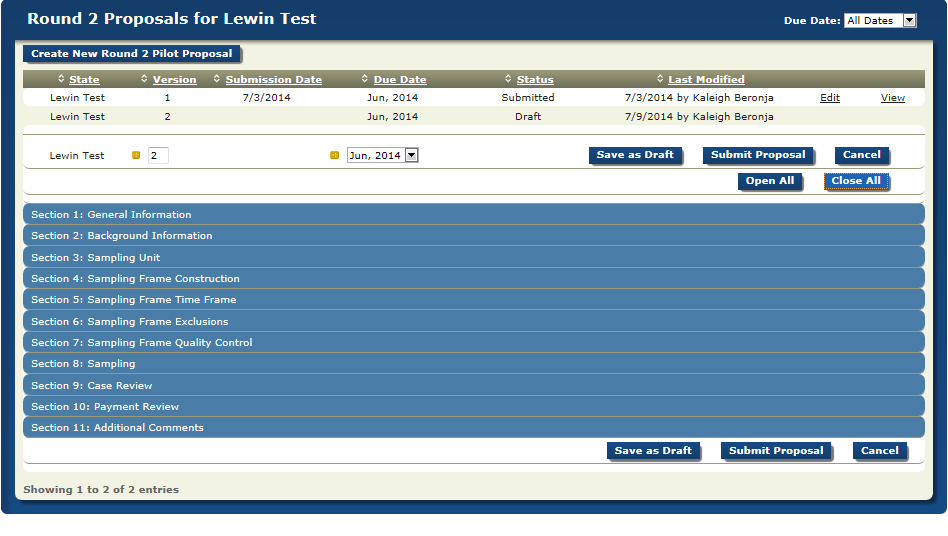
Figure 12: View with a Single Section Open
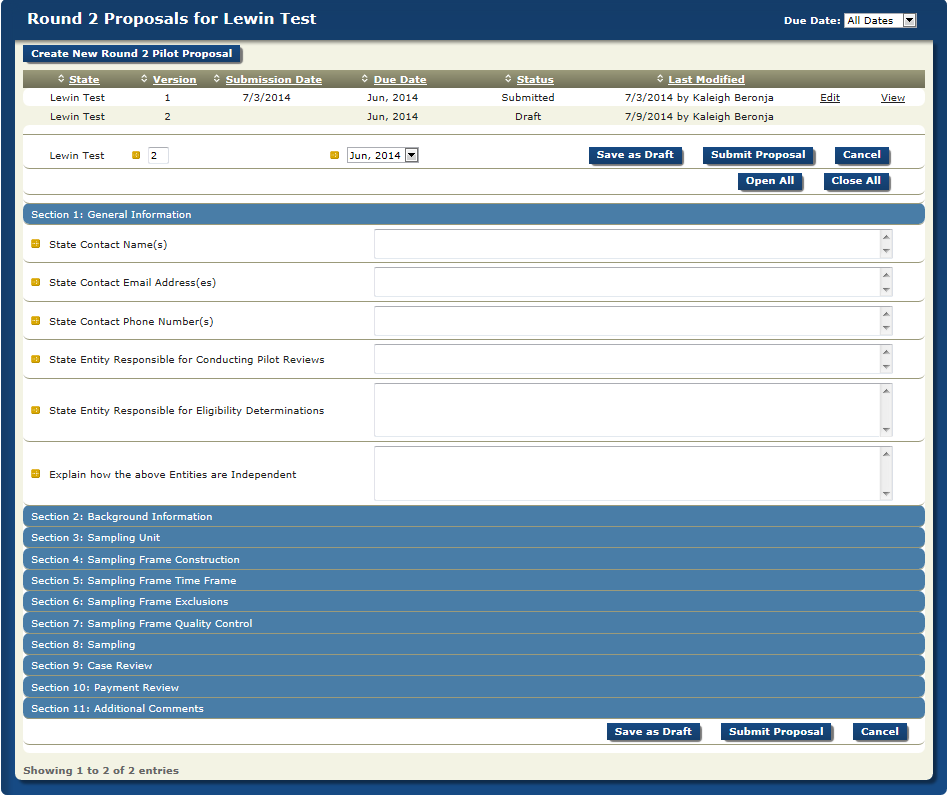
Instructions for populating each field can be accessed by hovering the cursor over the gold square to the left of the field under review, as demonstrated in Figure 13. Entries are typically free-form text, drop-down box selections, or calendar dates. You can use the Tab button on your keyboard to move from one entry box to the next entry box. This is especially useful when there is a series of numeric entries. As provided in the instructions submitted to states,1 there are a total of 11 sections that states will need to complete on PETT 2.0 to meet the pilot proposal reporting requirements. Guidance for populating each section is provided below. Each question is listed with the type of input required in parenthesis (i.e., number, text, calendar, etc.) and a description of the item. NOTE: All fields in the form are required. If there is a field that the state does not need to populate (e.g., if a state does not have any CMS-approved Mitigation Plans, Strategies, or Waivers, and is asked to describe the implications that these have on the pilot), the user must enter “NA” in the field. If any fields are left blank, aside from the additional comments, the site will not allow the proposals to be submitted.
Figure 13: Accessing Pilot Proposal Instructions
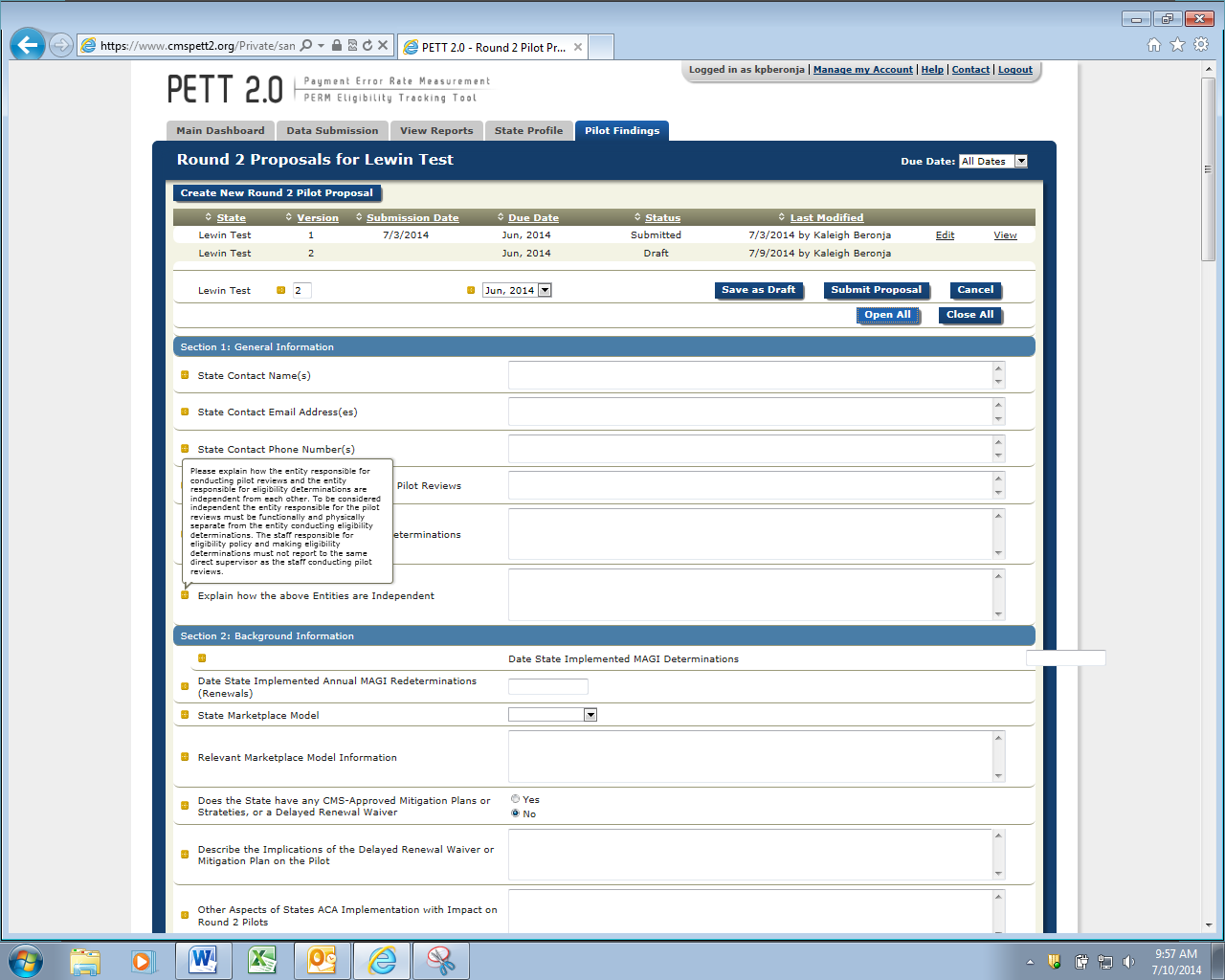
Figure 14 shows the Section 1 required fields. Below, each field is described in detail.
Figure 14: General Information

State Contact Name(s): (Text)
Please provide the contact name or names for all individuals who should be contacted with questions or comments related to the Round 2 Pilot Proposal.
State Contact E-mail Address(es): (Text)
List the e-mail addresses for individuals who should be contacted with questions or comments related to the Round 2 pilot proposal.
State Contact Phone Number(s): (Text)
Please provide the phone number for all individuals who should be contacted with questions or comments related to the Round 2 pilot proposal.
State Entity Responsible for Conducting Pilot Reviews: (Text)
Provide the specific information on the state entity responsible for conducting pilot reviews.
State Entity Responsible for Eligibility Determinations: (Text)
Provide the specific information on the state entity responsible for eligibility determinations.
Explain how the above Entities are Independent: (Text)
Please explain how the entity responsible for conducting pilot reviews and the entity responsible for eligibility determinations are independent from each other. To be considered independent the entity responsible for the pilot reviews must be functionally and physically separate from the entity conducting eligibility determinations. The staff responsible for eligibility policy and making eligibility determinations must not report to the same direct supervisor as the staff conducting pilot reviews.
Figure 15 shows the Section 2 required fields. Below, each field is described in detail.
Figure 15: Background Information
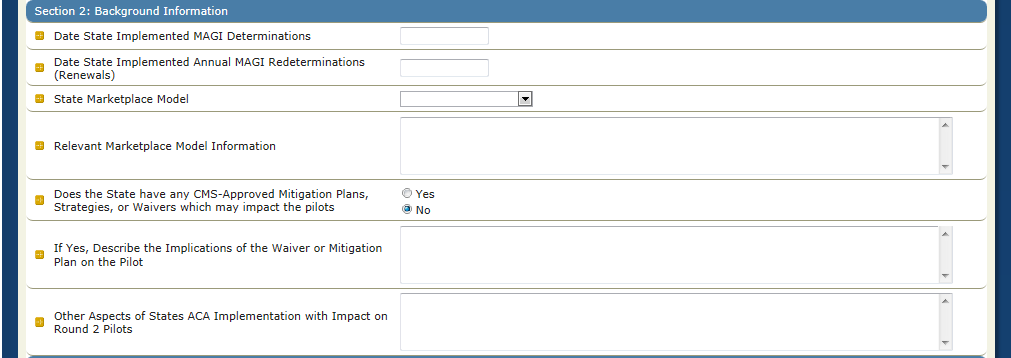
Date State Implemented MAGI Determinations: (Calendar)
Click inside the entry box and a calendar will appear. Select the date your state started determining Medicaid/CHIP eligibility using new MAGI rules. (e.g., if the state began making MAGI determinations on November 15, 2013 for applicants applying for
Medicaid benefits starting January 1, 2014, the state would enter 11/15/13 in this field).
Date State Implemented Annual MAGI Redeterminations (Renewals): (Calendar)
Click inside the entry box and a calendar will appear. Select the date your state implemented annual renewals based on MAGIs. This date should be consistent with any mitigation plan or waivers the state has in place.
State Marketplace Model: (Choose one)
Please select your state marketplace model from the drop-down box (e.g., SBM, FFM determination, or FFM assessment).
Relevant Marketplace Model Information: (Text)
Describe transition, if any, from one model to another during the pilot timeframe.
Does the State have any CMS-Approved Mitigation Plans or Waivers: (Yes/No)
Select yes or no based on whether or not your state has any CMS-approved mitigation plans, strategies, or waivers which may impact the eligibility review pilots, please describe (EG: Delayed renewals, targeted enrollment strategies, flat file waiver).
If Yes, Describe Implications of the Delayed Renewal Waiver or Mitigation Plan on the Pilot: (Text)
Describe the implications of the delayed renewal waiver or mitigation plan on the pilot.
Other Aspects of State’s ACA Implementation with Impact on Round 2 Pilots: (Text)
Please indicate any other aspects of the ACA’s implementation that will impact your state’s round 2 pilots.
Figure 16 shows the Section 3 required fields. Below, each field is described in detail.
Figure 16: Sampling Unit

Describe Sampling Unit Level: (Choose one)
Please select your state’s sampling unit level from the provided list of options (e.g., individual, household).
Define Active Determination and Negative Determination for your State: (Text)
Please explain your state’s definition of active determination and negative determinations in detail. The exact definition of determination types may be state-specific. In general, however, CMS considers the following as reasonable guidelines for defining active and negative determinations for purposes of this pilot:
Active Determination: A MAGI-based determination that approved a new applicant enrollment in Medicaid or CHIP or continued a beneficiary’s Medicaid or CHIP enrollment.
Negative Determination: A MAGI-based determination that denied a new applicant enrollment in Medicaid or CHIP or terminated a beneficiary from Medicaid or CHIP.
Define Initial Determination and Redetermination for your State: (Text)
Please explain your state’s definition of initial determinations and redeterminations in detail. Please also include details of what is considered a change of circumstance redetermination if this applies to your state for the purpose of this pilot. The exact definition of determination types may be state-specific. In general, however, CMS considers the following as reasonable guidelines for defining initial determinations and redeterminations for purposes of this pilot:
Initial Determination: A MAGI-based determination where the state took action to determine eligibility based on an initial application. This includes determinations made for applications that left the program and later reapplied.
Redetermination: A MAGI-based determination where the state took action to continue eligibility for a beneficiary or terminate eligibility for a beneficiary. These include annual redeterminations and redeterminations made outside the annual renewal process that are a result of a change in circumstances that require redetermination or eligibility.
Figure 17 shows the Section 4 required fields. Below, each field is described in detail.
Figure 17: Sampling Frame Construction
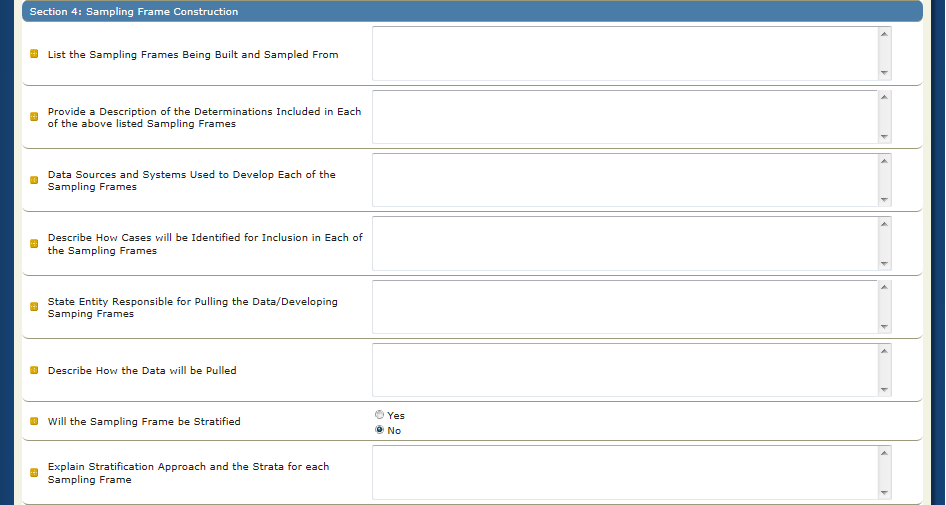
List the Sampling Frames Being Built and Sampled from: (Text)
Please list the sampling frames being built and sampled from. Note that states must build and sample from at least three separate sampling frames including: Medicaid active determinations, CHIP active determinations, and Negative determinations.
Provide a Description of the Determinations Included in Each of the above Listed Sampling Frames: (Text)
Provide a description of the determinations (e.g. active, negative, initial, or redeterminations) included in each of the above listed sampling frames for your state. It should be clear from this description that all sampling frame requirements will be met (e.g. includes only determinations made by the state, only full eligibility determinations for presumptive eligibility cases included, etc.). It should also be clear from this description how your state separated Medicaid and CHIP (i.e. funding source- Title XIX vs. Title XXI).
Data Sources and Systems Used to develop each of the Sampling Frames: (Text)
Please specify the data sources and systems used to develop each of the sampling frames for your state.
Describe how Cases will be identified for Inclusion in each of the Sampling Frames: (Text)
Please describe in detail how cases will be identified (e.g. aid category) for inclusion in each of the sampling items for your state.
State Entity Responsible for Pulling the Data/Developing Sample Plans: (Text)
Please identify the state entity which will actually select the data and develop the sampling frames from the state’s eligibility system(s).
Describe how the Data will be pulled: (Text)
Please describe in detail your state’s approach for how the data will be pulled (e.g. SQL query).
Will the Sampling Frame be Stratified: (Yes/No)
Please select whether or not your state’s sampling frame will be stratified.
If Yes, Explain Stratification Approach and the Strata for each Sampling Frame: (Text)
If your state is stratifying its sampling frame, please explain the stratification approach and the strata for each sampling frame. Be sure to specify the field(s) on which the data will be stratified and how the state will identify determinations to be included in each strata.
Figure 18 shows the Section 5 required fields. Below, each field is described in detail.
Figure 18: Sampling Frame Time Frame

Timeframe of Determinations from which the State is sampling: (Text)
Please detail the timeframe of determinations (including initial determinations and redeterminations) from which your state is sampling. Note that states must sample from eligibility determinations made between April 2014 and September 2014 but can choose a smaller timeframe within this 6 month review period.
Describe how the State is Identifying Determinations within this Timeframe and Excluding Determinations outside of this Timeframe: (Text)
Please describe how your state is identifying determinations within this timeframe and excluding determinations outside of this timeframe. Please note that the parameter states should use when developing the sampling frame is the determination date (i.e., decision date).
Section 6 – Sampling Frame Exclusions
Figure 19 shows the Section 6 required fields. Below, each field is described in detail.
Figure 19: Sampling Frame Exclusions
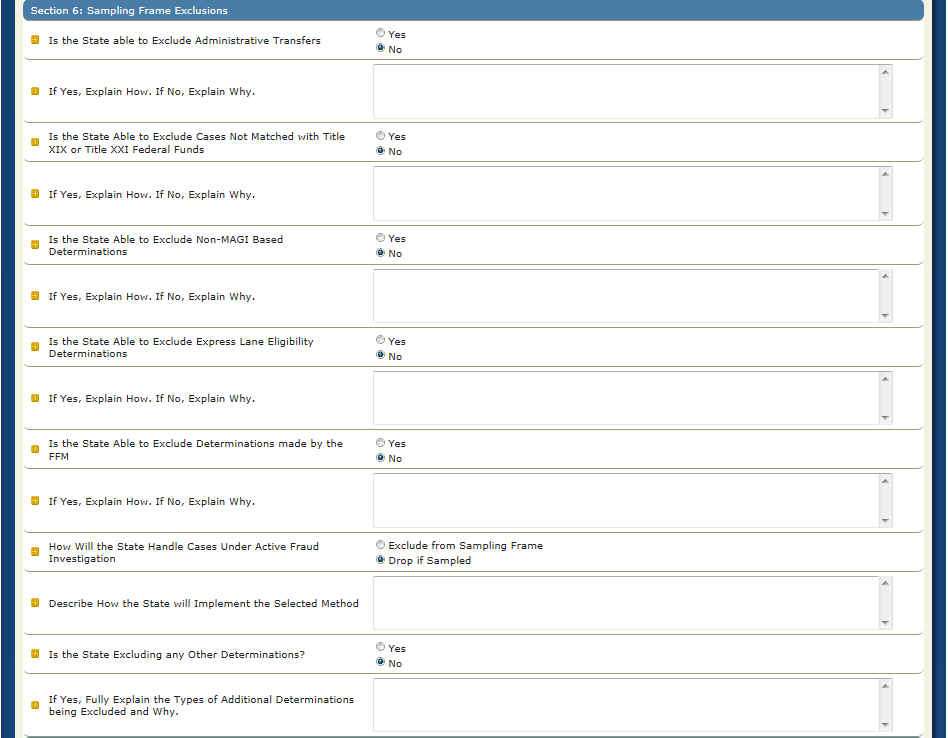
Is the State able to Exclude Administrative Transfers: (Yes/No)
Please indicate whether or not your state can exclude administrative transfers from the sampling frame prior to sampling.
If Yes, Explain How. If No, Explain Why: (Text)
If yes, please provide specific information regarding how your state is able to identify administrative transfers and how these determinations will be removed from the sampling frame prior to sampling. If no, please specify in detail why these determinations cannot be removed from the sampling frame prior to sampling.
Is the State Able to Exclude Cases Not Matched with Title XIX or Title XXI Federal Funds: (Yes/No)
Please indicate whether or not your state can exclude cases not matched with Title XIX or Title XXI Federal Funds from your sampling frame prior to sampling.
If Yes, Explain How. If No, Explain Why: (Text)
If yes, please provide specific information regarding how your state is able to identify cases matched with Title XIX or Title XXI Federal Funds. If no, please specify in detail why these determinations cannot be removed from the sampling frame prior to sampling.
Is the State Able to Exclude Cases Non-MAGI Based Determinations: (Yes/No)
Indicate whether or not your state can exclude non-MAGI determinations from the sampling frame prior to sampling.
If Yes, Explain How. If No, Explain Why: (Text)
If yes, please provide specific information regarding how your state is able to identify non-MAGI determinations and how those determinations will be removed from the sampling frame prior to sampling. If no, please specify in detail why these determinations cannot be removed from the sampling frame prior to sampling.
Is the State Able to Exclude Express Lane Eligibility Determinations: (Yes/No)
Indicate whether or not your state can exclude express lane eligibility determinations from the sampling frame prior to sampling.
If Yes, Explain How. If No, Explain Why: (Text)
If yes, please provide specific information regarding how your state is able to identify express lane eligibility determinations and how those determinations will be removed from the sampling frame prior to sampling. If no, please specify in detail why these determinations cannot be removed from the sampling frame prior to sampling.
Is the State Able to Exclude Determinations made by the FFM: (Yes/No)
Indicate whether or not your state can exclude determinations made by the FFM from the sampling frame prior to sampling.
If Yes, Explain How. If No, Explain Why: (Text)
If yes, please provide specific information regarding how your state is able to identify determinations made by the FFM and how those determinations will be removed from the sampling frame prior to sampling. If no, please specify in detail why these determinations cannot be removed from the sampling frame prior to sampling.
How will the State Handle Cases under Active Fraud Investigation: (Choose one)
Cases under active fraud investigation should not be included in the sample. Please specify if your state is able to exclude these cases from the sampling frame or if these cases will be dropped if sampled.
Describe how the State will implement the Selected Method: (Text)
Please describe in detail how your state will treat cases under active fraud investigation by either excluding them from the sampling frame or dropping the claims if sampled.
Is the State Excluding any Other Determinations: (Yes/No)
Please indicate if your state is excluding any other determinations from the sampling frame prior to sampling.
If Yes, Fully Explain the Types of Additional Determinations being excluded and Why: (Text)
If yes, please provide specific information regarding how your state is able to identify any other determinations as well as the reasons for proposing the exclusions.
Section 7 – Sampling Frame Quality Control
Figure 20 shows the Section 7 required field. Below, the field is described in detail.
Figure 20: Sampling Frame Quality Control

Describe the Quality Control Procedures that will be applied to ensure the Completeness/Accuracy of the Sampling Frame: (Text)
Please indicate the quality control procedures that your state will apply to the sampling frame to ensure completeness and accuracy.
Section 8 – Sampling
Figure 21 shows the Section 8 required fields. Below, each field is described in detail.
Figure 21: Sampling
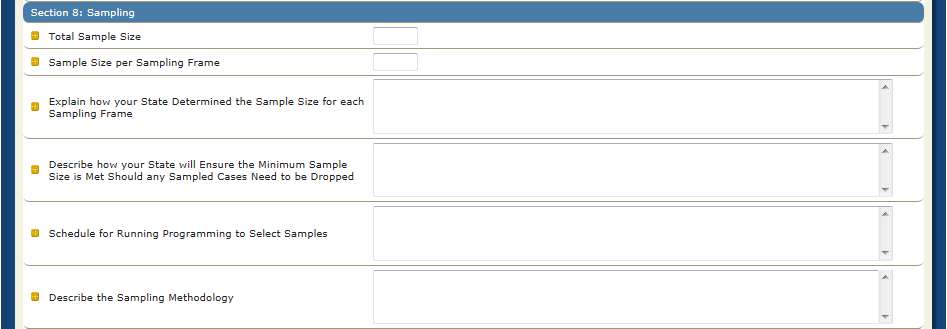
Total Sample Size: (Number)
Please indicate the total sample size for your state. Please note that the minimum sample size is 200 determinations for the entire six month review period of the Round 2 pilot to be reported in December 2014 and is inclusive of Medicaid, CHIP, active determinations, negative determinations, initial determinations, and redeterminations. Please note that states are encouraged to sample more than the minimum amount of determinations.
Sample Size per Sampling Frame: (Number)
Please indicate the total sample size per sampling frame for your state. You must provide the sample size that will be drawn from each sampling frame listed in section 4 of this proposal.
Explain how your State Determined the Sample Size for each Sampling Frame: (Text)
Please explain in detail how your state determined the sample size for each sampling frame.
Describe how your State will ensure the Minimum Sample Size is Met Should any Sampled Cases Need to be dropped: (Text)
Please describe how your state will ensure that the minimum sample size is met should any sampled cases need to be dropped. Please note that while oversampling is not required, states choosing to sample the minimum 200 may need to oversample to meet the minimum 200, if a case is dropped after the sample is pulled.
Schedule for Running Programming to Select Samples: (Text)
Please describe in detail your state’s schedule for running programming to select samples i.e. ” State will pull the sample in September” or “State will pull monthly samples the 5th day following the end of a month”
Describe Sampling Methodology: (Text)
Please describe in detail your state’s sampling methodology. Please note that states must utilize a random sampling methodology (e.g., simple random sample, or “skip” factor method). Please note that for states that stratify, your sampling methodology should reflect stratification.
Section 9 – Case Review
Figure 22 shows the Section 9 required fields. Below, each field is described in detail.
Figure 22: Case Review
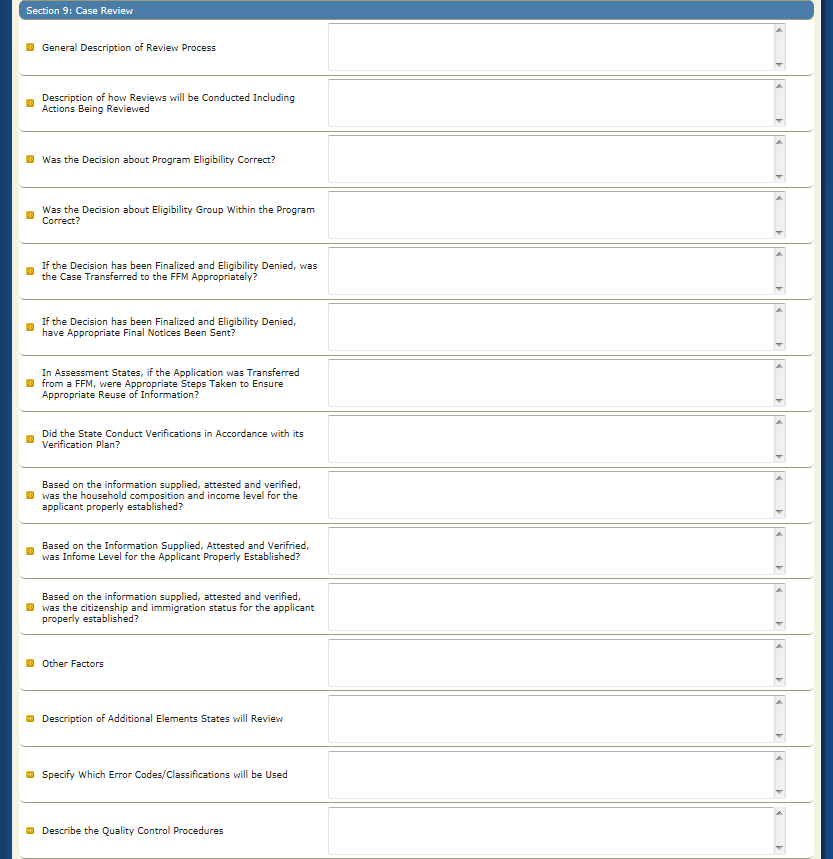
General Description of Review Process: (Text)
Please provide a general description of your state’s case review process including a timeframe planned for the reviews. This section is for more administrative information on how the state plans to complete the reviews. For example, states could provide information about how cases will be assigned to reviewers, what staff is conducting the reviews, what information the reviewers will access and how reviewers will capture and record results.
Description of how Reviews will be Conducted Including Actions Being Reviewed: (Text)
Please describe in detail how reviews will be conducted including actions being reviewed. Please note that states should look at all reviewable action, including review of actual caseworker action, as well as reviews of information available through screenshots of electronic sources that the state is utilizing throughout the eligibility determination process. Please note that states should be performing an end to end review of MAGI eligibility determinations from initial point of application/point of transfer to the final eligibility determination and the state’s description of the review process should provide this level of detail.
Was the Decision about Program Eligibility Correct?: (Text)
Please identify in detail how the state will review and report on the findings from the Round 2 pilot regarding the program decision. Indicate what process the state will use and what information the state will access to review for this element. If applicable, please identify the error codes that the state will cite to track cases with an incorrect program determination. Please note that Medicaid and CHIP should be treated as separate programs depending on Title XIX and Title XXI funding source.
Was the Decision about Eligibility Group within the Program Correct?: (Text)
Please identify in detail how the state will review and report on the findings from the Round 2 pilot regarding the eligibility group decision. Indicate what process the state will use and what information the state will access to review for this element. If applicable, please identify the error codes that the state will cite to track cases with an incorrect program determination. Please note this review should also ensure the correct hierarchy was used when placing an individual in their eligibility category.
If the Decision has been Finalized and Eligibility Denied, was the Case Transferred to the FFM Appropriately?: (Text)
If the decision has been finalized and eligibility was denied, please identify in detail how the state will track and report on whether sampled cases were appropriately transferred to the FFM. Indicate what process the state will use and what information the state will access to review for this element.
If the Decision has been Finalized and Eligibility Denied, have Appropriate Final Notices been Sent?: (Text)
If the decision has been finalized and eligibility was denied, please identify in detail how the state will review/track and report on whether the appropriate final notices were sent to all necessary entities. Indicate what process the state will use and what information the state will access to review for this element.
In Assessment States, if the Application was Transferred from a FFM, were Appropriate Steps Taken to Ensure Appropriate Reuse of Information?: (Text)
In assessment states, if the application was transferred from the FFM, please indicate how the state will review/track and report on whether the necessary steps were taken by your state to ensure appropriate reuse of information. Indicate what process the state will use and what information the state will access to review for this element. Please note that the review should include confirmation that information obtained from the FFM is used in the determination process in accordance with Medicaid and CHIP regulations and a state’s verification plan.
Did the State Conduct Verifications in Accordance with its Verification Plan?: (Text)
Please indicate how your state will track and report on whether the state conducted verifications in accordance with its verification plan. Indicate what process the state will use and what information the state will access to review for this element. Please note that the review should include a determination of whether or not appropriate attestations/verifications were made for data collected in the application/renewal as identified in the state’s verification plan. The review should determine whether or not any additional information sought from the applicant/beneficiary was properly requested based on attestation/verifications or existing data and utilized properly.
Based on the Information Supplied, Attested and Verified, was the Household Composition for the Applicant Properly Established?: (Text)
Please indicate how your state will track and report on whether the household composition for the applicant was properly established by your state based on the information supplied, attested and verified. Indicate what process the state will use and what information the state will access to review for this element. The review for this element should ensure that the tax filing status information included on the application was used correctly when establishing household composition.
Based on the Information Supplied, Attested and Verified, was Income Level for the Applicant Properly Established?: (Text)
Please indicate how your state will review/track and report on whether the income level for the applicant was properly established by your state based on the information supplied, attested and verified. Indicate what process the state will use and what information the state will access to review for this element.
Based on the Information Supplied, Attested and Verified, was the Citizenship and Immigration Status for the Applicant Properly Established?: (Text)
Please indicate how your state will review/track and report on whether citizenship and immigration status for the applicant were properly established by your state based on the information supplied, attested and verified. Indicate what process the state will use and what information the state will access to review for this element.
Description of Additional Elements State will Review: (Text)
Please provide a description of all other elements the state is reviewing for in addition to the questions listed above. Also include details about how your state will review for other required reporting elements including analysis by point of application, type of application, and channel (i.e. how these characteristics are captured and recorded during the review process) for each of the sampled determinations.
Specify which Error Codes/Classifications will be Used: (Text)
Please provide a clear description of how errors and deficiencies will be identified and classified by your state. This description should indicate what codes will be used and what errors/deficiencies will fit into each code for both active and negative determinations.
Describe the Quality Control Procedures for Ensuring Accuracy of the Review Decisions: (Text)
Please describe the quality control procedures for ensuring accuracy of the review decisions by your state. Please note that states are required to implement quality control measures to ensure accuracy of the reviews and to describe such measures in the pilot proposals.
Section 10 – Payment Review
Figure 23 shows the Section 10 required fields. Below, each field is described in detail.
Figure 23: Payment Review

Describe the State’s Payment Review Methodology: (Text)
Please describe in detail your state’s payment review methodology. Please include the timeframe established for collecting payments and which payments will be collected.
Section 11 – Additional Comments
Figure 24 shows the Section 11 required field. Below, the field is described in detail.
Figure 24: Additional Comments

Provide Any Additional Comments: (Text)
As needed, please provide any additional comments regarding your state’s pilot study which will support CMS’s review of your state’s proposal.
Please submit all questions on the content of Round 2 Pilot Proposals to [email protected]. Any questions on the use of the PETT 2.0 website should be directed to [email protected].
After a state has entered the Round 2 Pilot Proposals and confirmed the completeness and accuracy of the information, states should click the “Submit Proposal” button, as shown in Figure 25.
Figure 25: Submit Proposal
![]()
Upon submission, CMS will be notified that the state has submitted its pilot proposal. At that time, the state’s status on the home page will change to “Submitted- Under CMS Review.” CMS will then conduct a review of the state’s proposals and will provide comments or approval within 2 weeks, via the PETT 2.0 site.
States will not be able to make any changes to the Round 2 Pilot Proposals as long as the status of the report is “Submitted- Under CMS Review.” When CMS has completed its review, CMS will change the status to “Approved” or “Submitted - State Revising” if revisions are needed. State users will receive an email notification when CMS changes the state’s report status. NOTE: This functionality is not yet working but is in process. States are asked to refrain from making any changes to the Round 2 Pilot Proposal after submission to CMS.
If CMS approves the state’s pilot proposals, users can no longer edit the information. If a state has to make a change, a state user must contact CMS to change the status of the report back to “Submitted - State Revising.”
If CMS has comments on the state’s pilot proposals, CMS will change the status of the report back to “Submitted – State Revising.” State users will see the CMS comments in comment boxes throughout the Round 2 Pilot Proposal form. State users should proceed with making updates and edits in response to the CMS comments and resubmit the report for CMS review.
.
1 http://www.cms.gov/Research-Statistics-Data-and-Systems/Monitoring-Programs/Medicaid-and-CHIP-Compliance/PERM/Downloads/Round2MedicaidandCHIPEligibilityReviewPilotGuidance.pdf
| File Type | application/vnd.openxmlformats-officedocument.wordprocessingml.document |
| Author | Kaleigh Beronja |
| File Modified | 0000-00-00 |
| File Created | 2021-01-31 |
© 2025 OMB.report | Privacy Policy